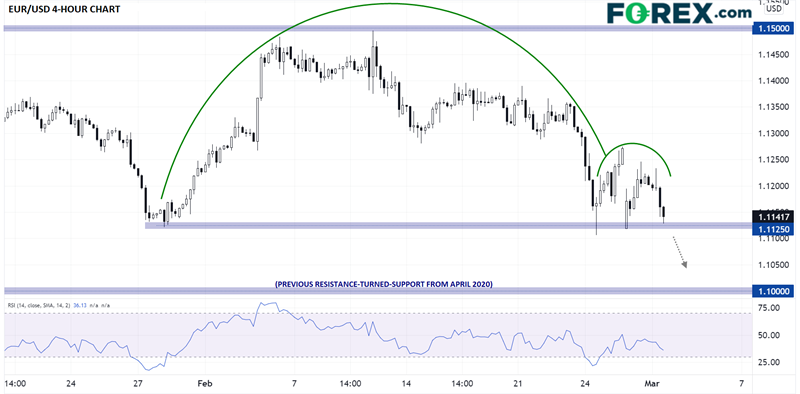The escalating conflict in Ukraine has had a predictable impact on the world’s most widely-traded currency pair: When Russia’s invasion began in earnest last Wednesday evening, EUR/USD dumped more than 200 pips in about 24 hours as traders priced in greater risk for the nearby Eurozone and fled to the safety of the world’s reserve currency.
While the pair has stabilized above that key support level over the last couple of trading days, the ongoing military clash may soon drive EUR/USD to its lowest levels in more than 20 months. Recent headlines that Russia is escalating nuclear preparations and that the West is imposing increasingly tough sanctions, including freezing assets and cutting off certain Russian entities from the SWIFT interbank communications network, suggest that the risk-off tone may linger throughout the week and potentially beyond.
From a technical perspective, EUR/USD remains (barely) within its 1.1125-1.1500 range from February, but after a shallow bounce heading into the weekend, rates are once again on the verge of breaking lower as we head to press. Indeed, fans of classic technical analysis may even identify February’s price action as an “inverted cup-and-handle” formation, showing growing selling pressure on 1.1125 support and the potential for a quick move down to 1.1000 or lower if that level gives way in the coming days:

Source: TradingView, StoneX
For reference, the 1.1000 level, in addition to being a psychologically-significant round number, was also a repeated area of resistance back in April 2020; as always, previous resistance levels, once broken, have a higher probability of turning into support in the future. To capitalize on this setup, bearish-inclined traders could consider setting a stop sell order near the 1.1100 handle with a stop back above 1.1125 and an initial target near potential support at 1.1000.
Despite the current bearish technical/fundamental backdrop, it’s important to remember that the broader environment remains highly fluid, so it helps to prepare for multiple potential outcomes. In that vein, signs of a ceasefire in Ukraine and/or a bounce above this week’s high near 1.1250 in EUR/USD would erase the near-term bearish bias and suggest that February’s range may hold through at least the first week of March.
